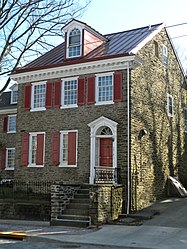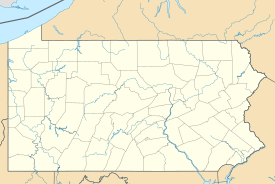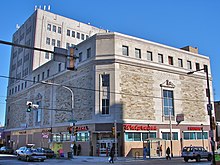Colonial Germantown Historic District
| Colonial Germantown Historic District | ||
|---|---|---|
| National Register of Historic Places | ||
| Historic District | ||
| National Historic Landmark | ||
|
Howell House in the Colonial Germantown Historic District |
||
|
|
||
| location | Germantown , Philadelphia , Pennsylvania | |
| Coordinates | 40 ° 2 '2.7 " N , 75 ° 10' 19.1" W | |
| Built | from 1683 | |
| NRHP number | 66000678 | |
| Data | ||
| The NRHP added | October 15, 1966 | |
| Declared as HD | June 23, 1965 | |
| Declared as an NHL | June 23, 1965 | |
Colonial Germantown Historic District is a historically significant district in Germantown , Pennsylvania and is considered the first German settlement in America .
history
Colonial Germantown was founded in 1683 under the direction of Franz Daniel Pastorius , who followed William Penn's call to Pennsylvania. Before Pastorius reached America on August 20, 1683, he had already received land from Penn and motivated compatriots who were religiously persecuted to emigrate together. It was followed on October 6th by Concord with 13 families from the Dutch- dominated Krefeld , who were active as linen weavers and traders. This date is celebrated today as German-American Day . The subsequently built settlement is considered the first German in the Thirteen Colonies . Until 1709 the Colonial Germantown Historic District remained predominantly Dutch. Afterwards, the character of the settlement changed due to increasing German immigration, which reached its peak around the middle of the century. Colonial German Town benefited from the nearby paper mill of Rettinghaus family on Mono Sheene Creek and became a center of German book printing . In 1743 Johann Christoph Sauer created the first American Bible to be printed in a European language . Opened in 1749, Union School was the first school in Colonial Germantown. In 1758 the settlement consisted of about 350 houses and was mainly inhabited by German Quakers , Tunkers and Mennonites . Until 1800, textile production and tanneries in particular shaped the economy of Colonial Germantown, while the surrounding country was little developed. At the Battle of Germantown in 1777, the Cliveden Estate was a major site of the conflict and is now the most important surviving memorial to the event. During November 1793, George Washington briefly returned to Colonial Germantown to hold cabinet meetings outside of the yellow fever- ridden capital Philadelphia . In the following years the settlement broke away from its isolation and was Americanized . In the 1790s, Colonial Germantown had no more than 2,500 residents. In 1832 a railroad line connected Germantown with Philadelphia. In 1854 Colonial Germantown was incorporated into Philadelphia .
Between the end of the American Civil War and 1900, Colonial Germantown grew significantly and a business and commercial center developed especially along Germantown Avenue. After the Second World War, the place recorded a further increase in construction activity, so the CA Rowell department store was built at this time. In the 1960s, the economic importance of Colonial Germantown declined in view of the shopping malls that were now emerging in the area . About half of the almost 500 houses that still existed at the beginning of the 1980s came from the period between the civil war and the following turn of the century, while a little over 10% were built before 1800.
On June 23, 1965, the district was designated as a Historic District and declared a National Historic Landmark . On October 15, 1966, the Colonial Germantown Historic District was added to the National Register of Historic Places .
architecture
From 1850 onwards, the building styles that had been common in the settlement up to that point, such as Georgian architecture, were increasingly broken up by elements of neo-Gothic , neo-Baroque and Italianate styles , with redesigning of existing buildings. Victorian architecture dominated until the turn of the century , with the Italianate style and Second Empire being particularly popular from 1860 to 1880 . After that they were gradually supplanted by the Colonial Revival, which combined Georgian and neoclassical stylistic devices. During this time, elements from the Queen Anne style also appear. Colonial Germantown is best known for the rich variety of colonial and federal style houses . Cliveden, Wyck House , Loudoun Mansion, Vernon-Wister House and Upsala are particularly impressive examples .
Web links
- Historic Germantown: Freedom's Backyard. In: website freedomsbackyard.com. Retrieved September 21, 2014 .
Individual evidence
- ↑ Wolfgang Grams: Farewell - crossing - arrival. German emigration and travel routes to America . In: Elisabeth Fendl, Tilman Kasten, Werner Mezger, Michael Prosser-Schell, Hans-Werner Retterath (eds.): Yearbook for German and Eastern European Folklore . Off to overseas! German emigration from Eastern Europe. tape 54 . Waxmann , Münster 2013, ISBN 978-3-8309-7820-6 , pp. 9 (257 p., Limited preview in Google Book search).
- ^ Cliveden. (No longer available online.) In: National Historic Landmarks Program (NHL). National Park Service , archived from the original on September 25, 2012 ; accessed on September 20, 2014 . Info: The archive link was inserted automatically and has not yet been checked. Please check the original and archive link according to the instructions and then remove this notice.
- ^ A b Carl E. Doebley, Mark Lloyd: 1982 National Register of Historic Places Inventory - Nomination Form. (No longer available online.) National Park Service , December 10, 1982, archived from the original on October 20, 2013 ; Retrieved September 20, 2014 (in English, mirror of the nomination form on Bryn Mawr College website ). Info: The archive link was inserted automatically and has not yet been checked. Please check the original and archive link according to the instructions and then remove this notice.
- ^ Colonial Germantown Historic District. (PDF) In: National Register of Historic Places Inventory: Nomination Form. National Park Service , July 20, 1977, accessed September 12, 2014 (PDF 912 KB).
-
^ Colonial Germantown Historic District. (No longer available online.) In: National Historic Landmarks Program (NHL). National Park Service , archived from the original on September 1, 2012 ; accessed on September 19, 2014 (English). Info: The archive link was inserted automatically and has not yet been checked. Please check the original and archive link according to the instructions and then remove this notice. Listing of National Historic Landmarks by State: Pennsylvania. National Park Service , accessed February 11, 2020.
- ↑ Entry on the National Register of Historic Places , accessed September 19, 2014



